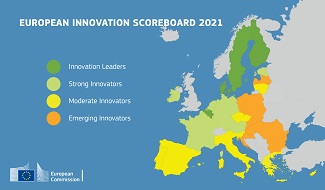2021 European Innovation Scoreboard: Where is Innovation Thriving in Europe?
/2021_eis_page_map_of_innovation_performance_dark.jpg)
On 21 June 2021 the European Commission released its latest annual European Innovation Scoreboard (“EIS”), after the adoption of the updated EU Industrial Strategy of 5 May 2021, which addresses new conditions following the COVID-19 crisis “to drive Europe’s industrial transformation to a more sustainable, digital, resilient and globally competitive economy”.
The Nordic countries of Denmark, Finland, Iceland, Norway and Sweden have long enjoyed a reputation for being among the most business-friendly locations for innovation-oriented enterprises. This holds true for mature global companies as well as SMEs and startups. The Finnish startup ecosystem, for example, is often described as the most attractive in Europe and, indeed, Finland hosts Slush, perhaps the world´s most famous annual startup event and community.
European Commission's 2021 Innovation Scoreboard
On 21 June 2021 the European Commission released its latest annual European Innovation Scoreboard (“EIS”), after the adoption of the updated EU Industrial Strategy of 5 May 2021, which addresses new conditions following the COVID-19 crisis “to drive Europe’s industrial transformation to a more sustainable, digital, resilient and globally competitive economy”.
In this new framework, new indicators were added to the EIS, namely (1) digitalization and (2) sustainable innovation. For the complete list of the indicators which were used, please see below.
It’s also important to highlight the European Commission's disclaimer that much of the data analyzed in the EIS is not sufficiently recent to be able to account for the full impact of the Covid-19 pandemic on innovation in Europe.
Quoting directly from the report “[t]he annual European Innovation Scoreboard (EIS) provides a comparative assessment of the research and innovation performance of EU Member States and selected third countries, and the relative strengths and weaknesses of their research and innovation systems. It helps countries assess areas in which they need to concentrate their efforts in order to boost their innovative performance.”
The overall rankings are based on a cumulative score over a wide range of criteria. Based on the overall score, the report groups countries in the following categories: modest innovators, moderate innovators, strong innovators and innovation leaders.
Only four EU countries scored a sufficient number of cumulative points to be considered innovation leaders, the top 3 of which are the Nordic countries of Sweden (156 points), Finland (151 points) and Denmark (148 points). Each of these countries achieved scores that are substantially higher than the results from the IP5 group comprising China, the United States, Japan, South Korea and the European Union (EU average).
The scores were determined by carefully evaluating the following twelve “innovation dimensions” that are listed in Table 1 of the EIS entitled Measurement Framework of the European Innovation Scoreboard.
- Human resources (new doctorate graduates in STEM, population aged 25-34 with tertiary education, lifelong learning)
- Attractive research systems (international scientific co-publications, top 10% most cited publications, foreign doctorate students)
- Digitalisation (broadband penetration, individuals who have above basic overall digital skills)
- Finance and support (R&D expenditure in the public sector, venture capital expenditures, direct government funding and government tax support for business R&D)
- Firm investments (R&D expenditure in the business sector, non-R&D innovation expenditures, innovation expenditures per person employed in innovation-active enterprises)
- Use of information technologies (enterprises providing training to develop or upgrade ICT skills of their personnel, employed ICT specialists)
- Innovators (SMEs with product innovations, SMEs with business process innovations)
- Linkages (innovative SMEs collaborating with others, public-private co-publications, job-to-job mobility of human resources in science and technology)
- Intellectual assets (PCT applications, trademark applications, design applications)
- Employment assets (employment in knowledge-intensive activities, employment innovative enterprises)
- Sales impacts (medium and high-tech product exports, knowledge-intensive services exports, sales of product innovations)
- Environmental sustainability (resource productivity, air emissions by fine particulates PM2.5 in industry, development of environment-related technologies)
A link to the 2021 European Innovation Scoreboard can be found here.
Conclusion
These impressive results may come as a surprise to those not so familiar with the innovation climate in Nordic countries today, but they reflect the innovative culture and the effective support provided by the Nordic countries to their innovation ecosystems.
This article was co written by Mariella Massaro (Partner, J.D., IP Strategist, Certified Licensing Professional, International Client Relations) and Robert Alderson (Partner, United States and European Patent Attorney, International Client Relations) of Berggren Oy, a Full-Service European Intellectual Property Law Firm, headquartered in Helsinki, Finland.
/)

/Gennaio_2020_B_(2).jpg)

/canvascolor(0xffffffff)/NURIS_logo-07.png)
/canvascolor(0xffffffff)/ppnt_logo_EN.png)
/canvascolor(0xffffffff)/Logo_Bioindustry_nuovo_1.jpg)
/canvascolor(0xffffffff)/buildings2.png)
/canvascolor(0xffffffff)/Lion_scienc_park_black_trans_3.png)
/canvascolor(0xffffffff)/MemberLogo-5557-5966.jpg)
/canvascolor(0xffffffff)/KENNISPARK-TWENTE_FC-LOGO-1-800x220_1.png)
/canvascolor(0xffffffff)/2017_07_31_tecnopuc.png)
/canvascolor(0xffffffff)/2021_01_26_Spain_PCT_Gipuzkoa.png)
/canvascolor(0xffffffff)/MemberLogo-5668-6103.gif)
/canvascolor(0xffffffff)/Norwich_Research_Park_Logo_artwork_transparent_bg_4.png)
/canvascolor(0xffffffff)/Aj_basa_2014_color-fonsgrisE_2.png)
/canvascolor(0xffffffff)/2023_07_27_Italy_Road_2.jpg)
/canvascolor(0xffffffff)/2019_08_02_UAE_RTI_Park.png)
/canvascolor(0xffffffff)/2019_06_12_Taiwan_Hsinchu_SP.JPG)
/canvascolor(0xffffffff)/Logo_ITP-01_1.jpg)
/canvascolor(0xffffffff)/2008_04_23_China_Zhengzhou_Hangmei_Internation.jpg)
/canvascolor(0xffffffff)/MemberLogo-61901-312801.png)
/canvascolor(0xffffffff)/2020_06_29_Sweden_Link_ping_SP.jpg)
/canvascolor(0xffffffff)/sip_zurich_rgb_transparent_1.png)
/canvascolor(0xffffffff)/ResearchPark_S_RGB_1.jpg)
/canvascolor(0xffffffff)/Logo_UO_4.jpg)
/canvascolor(0xffffffff)/2017_11_17_UK_Surrey_Research_Park.png)
/canvascolor(0xffffffff)/logo-eng_4.png)
